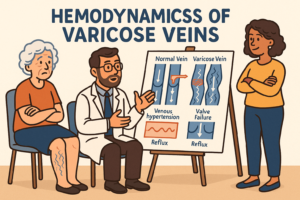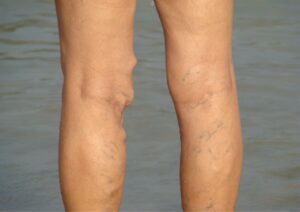High Heels: A Fashion Statement with Health Consequences
High heeled shoes, long celebrated as a symbol of elegance and style young women have in the fashion world, come with a less glamorous side—significant health consequences, particularly for individuals predisposed to or currently experiencing varicose veins.
Wearing high heeled shoes alters the natural posture and gait, shifting the distribution of body weight and placing increased pressure on the legs and feet. This shift not only strains the muscles and tendons but also affects blood flow.
For patients with varicose veins, the concern is that high heeled shoes exacerbate the condition by hindering the efficient return of blood from the legs to the heart. The calf muscles play a crucial role in this process, acting as a pump that assists in blood circulation. However, high heels limit the full range of motion of the ankles and reduce the effectiveness of the calf muscles, leading to decreased blood flow. This can cause blood to pool in the veins, potentially worsening the symptoms of varicose veins, such as pain, swelling, and the appearance of enlarged, twisted veins.
Over time, the continuous wear of high heeled shoes can contribute to the progression of varicose veins, making it important for individuals prone to or suffering from this condition to consider the impact of their footwear choices. Opting for shoes with lower heels and supportive insoles can help mitigate these risks, promoting better posture and foot stability, reducing pressure on the legs, and supporting healthier blood circulation. This shift in footwear choice, along with other lifestyle adjustments and medical treatments, can play a pivotal role in managing varicose veins and maintaining overall leg health.
What Research Says
Current research on the relationship between high heeled shoes usage and the development or exacerbation of varicose veins presents a nuanced understanding of the biomechanical and circulatory impacts of such footwear. Studies indicate that high heeled shoes can alter the natural walking mechanism, leading to increased strain on the lower extremities. This alteration affects calf muscle pump efficiency, a critical factor in promoting venous return from the legs to the heart. When the calf muscles are not fully activated, as is often the case with prolonged high heel wear, the efficiency of this pump decreases, potentially contributing to the pooling of blood in the legs. This stagnation can exacerbate the pressure within the veins, leading to or worsening existing varicose veins.
Moreover, research suggests that the continuous wearing of high heeled shoes can lead to structural changes in the leg muscles and veins, increasing the risk of venous insufficiency—a condition where the blood does not flow adequately back to the heart. These findings underscore the importance of moderation in both high heeled shoes alters and heel wear, especially for individuals at risk of or currently dealing with varicose veins. The scientific consensus advocates for a balanced approach to footwear, recommending lower heels and supportive shoes to mitigate the adverse effects on venous health. While the direct causality between the influence of high heeled shoes, heel use and varicose veins requires further study, the existing evidence points towards a significant correlation that warrants consideration in the management and prevention strategies for varicose veins. This body of research serves as a crucial reminder of the complex interplay between lifestyle choices and vascular health, urging a more informed approach to footwear for those concerned with or susceptible to varicose veins.
Effects of shoes on venous pressure
The effects of shoes on venous pressure in the legs highlight the intricate relationship between footwear choices and vascular health. Different types of shoes, particularly those with varying heel heights, can significantly impact the biomechanics of walking, the efficiency of the calf muscle pump, and ultimately, venous pressure. Footwear with elevated heels, for instance, limits the ankle’s range of motion and reduces the ability of the calf muscles to contract fully with each step. This reduced muscle activity diminishes the effectiveness of the calf muscle pump, a mechanism essential for facilitating venous return from the lower extremities back to the heart. As a result, blood flow slows, and venous pressure increases, which can lead to the pooling of blood in the legs, a key factor in the development and exacerbation of venous disorders such as varicose veins and chronic venous insufficiency.
Conversely, shoes that promote a more natural foot position, such as low-heeled or flat shoes, can enhance calf muscle activation and improve venous return. Studies have shown that wearing flat footwear can lead to a decrease in venous pressure, reducing the risk of venous pooling and its associated complications. The design and fit of the shoe also play crucial roles; well-fitted, high heeled shoes with adequate support can distribute body weight more evenly across the foot, further aiding in optimal venous return and minimizing undue stress on the venous system.
The implications of these findings are significant for individuals with existing venous conditions or those at risk for developing such issues. Choosing appropriate footwear becomes not just a matter of comfort or fashion, but a critical consideration for vascular health, underscoring the need for increased awareness about the effects of shoes on venous pressure and the potential long-term benefits of selecting footwear that supports the natural function of the venous system.
Impact of Venous hypertension on Leg Health
Venous hypertension, characterized by increased blood pressure within the veins of the legs, has a profound impact on leg health, manifesting through a spectrum of clinical symptoms and conditions that can significantly impair an individual’s quality of life. This condition arises from the failure of venous valves to function adequately and increase residual volume fraction, leading to the backward flow of blood and its subsequent pooling in the legs. The increased venous pressure stretches and weakens the venous walls, contributing to the development of varicose veins—visibly enlarged, twisted veins that can cause pain, swelling, and a heavy sensation in the legs. Beyond these visible signs, venous hypertension can lead to more severe complications, including chronic venous insufficiency (CVI), where the legs struggle to pump blood back to the heart effectively. This can result in edema, skin changes such as hyperpigmentation, eczema, and the formation of venous ulcers, which are challenging to heal and prone to infection.
Moreover, the elevated pressure and resultant chronic inflammation of venous complaints can damage the capillaries and skin, leading to a condition known as lipodermatosclerosis, where the skin becomes hardened and fibrotic. The cumulative effect of these changes in venous status not only leads to significant discomfort and mobility issues but also increases the risk of thrombosis, including deep vein thrombosis (DVT), a potentially life-threatening condition if a blood clot dislodges and travels to the lungs, causing a pulmonary embolism. The impact of venous hypertension on leg health underscores the importance of early diagnosis and comprehensive management of venous disease, including lifestyle modifications, compression therapy, and, in some cases, surgical interventions to alleviate symptoms, prevent progression, and improve overall leg function and quality of life.
A Closer Look at High Heels
Despite all we know, the exact effects of high heeled shoes on leg blood flow are still a bit unclear. In a recent study, we looked at women wearing different high heels and compared statistical difference in their leg blood flow to when they were high heel groups were walking barefoot again. We used a special technique, commonly used by doctors, to measure this.
A closer examination of high heels reveals their significant impact on blood flow and circulatory health, particularly in the lower extremities. High heels, by design, elevate the heel above the toes, leading to a forward shift in the body’s center of gravity. This alteration forces the body to compensate by bending forward at the hips and arching the back, disrupting the natural alignment of the spine and pelvis. Such postural changes not only strain the muscles and joints but also influence the circulatory system. Specifically, the elevation of the heel restricts the natural flexing of the foot and limits the ankle’s range of motion during walking. This limitation can significantly reduce the effectiveness of the calf muscle pump, an essential mechanism that facilitates venous blood return from the legs back to the heart.
When the calf muscles are not fully engaged, as is often the case with prolonged high heel wear, the efficiency of this muscle pump function decreases, potentially leading to venous stasis where blood pools in the lower legs. This pooling can increase venous pressure, exacerbating the risk of varicose veins, spider veins, and even deep vein thrombosis in susceptible individuals. Moreover, reduced blood flow can lead to a feeling of heaviness, fatigue in the legs, and contribute to swelling and discomfort over time. The impact of high heels on blood flow underscores the importance of moderation in their use, advocating for periods of rest and the choice of footwear that promotes proper foot alignment and supports the natural function of the calf muscle pump. For those who frequently wear high heels, incorporating exercises that strengthen the leg muscles and enhance blood flow, along with regularly alternating between heel height and heights, can help mitigate some of the adverse effects on circulatory health.
Interesting Findings from research paper
The findings of the study shed light on the physiological consequences of wearing high heels, particularly those with a height of 7 cm or more, revealing a surprising impact on leg blood flow. The research demonstrated that women wearing such high heels experienced a statistically significant a reduction in blood flow within their legs compared to periods when they were barefoot. This reduction in blood flow is attributed to the altered mechanics of gait posture, walking speed and posture induced by high heels. When wearing heels, the natural, gait posture is modified; the heel strike is minimized, and there is less flexion and extension in the ankle joint. This leads to decreased activation and effectiveness of the calf muscle pump, a critical component in facilitating venous return of blood back to the heart.
Moreover groups wearing high heels, the elevation of the heel off the ground increases the gravitational pull on the blood, making it more challenging for the veins to transport blood against gravity from the lower limbs and extremities back to the central circulation. This can result in venous pooling, where blood accumulates in the legs, contributing to an increased risk of varicose veins, spider veins, and leg fatigue. Additionally, the compromised blood flow can have broader implications for lower limbs and leg health, potentially leading to swelling, numbness, and in long-term cases, to more severe circulatory issues.
This study underscores the importance of understanding the health implications associated with fashion choices, particularly for individuals who regularly wear high heels. It prompts a reevaluation of footwear habits, encouraging the adoption of practices that mitigate these adverse effects, such as alternating heel heights, less heel height, incorporating periods of rest for the feet during the day, and engaging in exercises designed to enhance calf muscle strength and improve blood circulation in the legs. The research serves as a critical reminder of the need for a balance between aesthetics and health, emphasizing that the pursuit of fashion should not come at the expense of physical well-being.
Muscles and Blood Flow
Other research has looked into how wearing high and moderate heeled shoes, and heels affect muscles during walking. They found that wearing heels changes muscle activity, but this doesn’t necessarily say medium heels mean better blood flow. Good blood flow in the legs needs the calf muscles to work properly, and high heeled shoes present as heels can interfere with this.
For patients who wear high heels and suffer from varicose veins, understanding the relationship between muscles and blood flow is essential for managing and potentially alleviating their condition. High heels alter the natural alignment and function of the foot, which in turn impacts the leg muscles, particularly the calf muscles that play a pivotal role in venous blood flow. When wearing high heels, the foot is positioned at an angle that limits the range of motion of the ankle and reduces the ability of the calf muscles to contract fully. This restricted movement decreases the efficiency of the calf muscle pump, a mechanism that is crucial for propelling blood upwards against gravity back to the heart.
In the context of varicose veins, the weakened or damaged venous valves already struggle to prevent the backflow of blood, leading to pooling and increased venous pressure. The diminished calf muscle activity due to the influence of high heeled, heels exacerbates this issue, potentially worsening the symptoms of varicose veins, such as pain, swelling, and the visible appearance of the veins. Over time, the continuous use of high heels may contribute to the progression of venous disorders by impairing the natural blood flow and venous return.
For patients with varicose veins, incorporating lifestyle changes that enhance muscle activity and promote efficient blood flow is crucial. This includes opting for footwear that supports natural foot alignment and muscle function in young women, engaging in regular exercise that targets the leg muscles, especially activities that involve the calf muscles, and considering the use of compression stockings to aid in venous return. Such measures can help mitigate the impact of high heels on venous health, offering relief from symptoms and supporting overall leg wellness.
The Ideal Leg Health
For your legs to work their best and blood to flow smoothly, platform high heels, a few things are needed. Your leg veins should be healthy, there shouldn’t be any blockages, and your foot volume and ankle joint should move freely. High heels can restrict ankle movement, which can lead to poor blood flow, despite your leg veins being healthy.
The ideal leg health encompasses a state where the legs function optimally without pain, swelling, or any form of discomfort, allowing for unrestricted movement and activity. This involves not only the absence of visible conditions such as varicose veins or swelling but also the proper circulation of blood, venous function which is crucial for nourishing tissues and removing waste products efficiently. Optimal leg health is characterized by strong, flexible muscles that support and facilitate venous return, a critical component in preventing venous disorders such as chronic venous insufficiency.
Maintaining ideal leg health involves regular physical activity, which promotes muscle contraction and aids in pumping blood back to the heart, reducing the risk of blood pooling and venous hypertension. Adequate hydration, a balanced diet rich in antioxidants and anti-inflammatory foods, and the avoidance of prolonged periods of sitting or standing also contribute to maintaining the health of the legs. Wearing compression garments during extended periods of immobility, such as long flights or desk jobs, can further prevent the onset of swelling and varicose veins.
Moreover, ideal leg health includes skin integrity without ulcers, rashes, or eczema, which can indicate underlying vascular surgery circulatory problems. Regular check-ups with healthcare providers for individuals with risk factors for venous diseases, and immediate attention to any signs of discomfort or abnormality, are also integral to preserving leg health. Ultimately, the ideal leg health is a balance of structural, circulatory, and muscular wellness, enabling individuals to enjoy an active, pain-free lifestyle.
Conclusion
Wearing high heels for a short time can reduce the function of your calf muscles, as seen by changes in blood flow in our study. The higher values taller the heel, the higher values bigger the impact. Wearing high heels all the time can increase the pressure in your leg veins, leading to issues like varicose veins and other problems.
In a nutshell, while high heels add a lot of style to your wardrobe, they can also affect the health of your legs. It’s important to find a balance between looking good and staying healthy. Consider mixing up your shoe choices and giving your feet a break from high heels now and then.
Reference:
Cronin NJ, Barrett RS, Carty CP. Long-term use of high-heeled shoes alters the neuromechanics of human walking. J Appl Physiol (1985). 2012 Mar;112(6):1054-8. doi: 10.1152/japplphysiol.01402.2011. Epub 2012 Jan 12. PMID: 22241055.
Wiedemeijer MM, Otten E. Effects of high heeled shoes on gait. A review. Gait Posture. 2018 Mar;61:423-430. doi: 10.1016/j.gaitpost.2018.01.036. Epub 2018 Feb 7. PMID: 29475153.
Hapsari VD, Xiong S. Effects of high heeled shoes wearing experience and heel height on human standing balance and functional mobility. Ergonomics. 2016;59(2):249-64. doi: 10.1080/00140139.2015.1068956. Epub 2015 Oct 12. PMID: 26155823.
Shang J, Chen L, Zhang S, Zhang C, Huang J, Wang X, Yan A, Ma X. Influence of high-heeled shoe parameters on biomechanical performance of young female adults during stair ascent motion. Gait Posture. 2020 Sep;81:159-165. doi: 10.1016/j.gaitpost.2020.07.065. Epub 2020 Jul 28. PMID: 32738740.
Tedeschi Filho W, Dezzotti NR, Joviliano EE, Moriya T, Piccinato CE. Influence of high-heeled shoes on venous function in young women. J Vasc Surg. 2012 Oct;56(4):1039-44. doi: 10.1016/j.jvs.2012.01.039. Epub 2012 Apr 5. PMID: 22483354.
Potério-Filho J, Silveira SA, Potério GM, Fecuri RJ, de Almeida FH, Menezes FH. The effect of walking with high-heeled shoes on the leg venous pressure. Angiology. 2006 Aug-Sep;57(4):424-30. doi: 10.1177/0003319706290744. PMID: 17022377.









